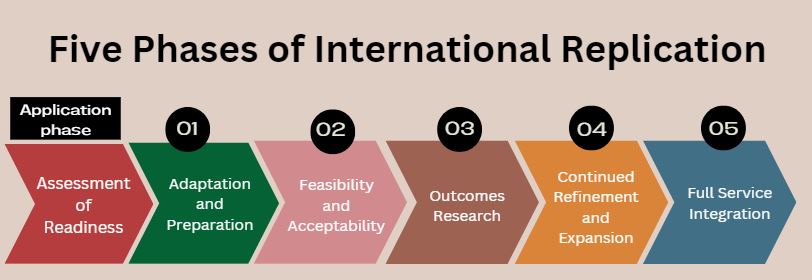Dr. Olds and his staff at the Prevention Research Center have developed a model for adapting and testing the Nurse-Family Partnership program in international contexts that is grounded in the same rigorous research standards that serve as a foundation for the U.S. program. This model has been sucessfully applied in all implementing countries around the world. After the application phase, international implementation effort has five phases:

Application Phase: Assessing capacity and readiness at national, regional and community levels by focusing on those dimensions that are necessary for laying the foundations for the successful implementation of NFP in a new country or society.
Phase One: Adaption. Examine the adaptations needed to deliver the NFP program in local contexts while ensuring fidelity to the NFP model.
Phase Two: Feasibility and Acceptability through Pilot Testing and Evaluation. Conduct a pilot test of the adapted NFP program to inform what additional adaptations may be needed to ensure the feasibility and acceptability of the adapted NFP program.
Phase Three: Randomized Controlled Trial (RCT). Consider expansion of the testing and evaluation work by conducting a Randomized Controlled Trial (RCT).
Phase Four: Continued Refinement and Expansion. Once the evaluation of the RCT has been completed and the outcomes found to be of public health significance, the implementing agency may decide to further refine and expand the adapted NFP Program in their society.
Phase Five: Full Service Integration. When the program has expanded widely within a country over a number of years, and the program has been fully established and integrated into the local health and care systems in a sustainable way, the country may progress to phase 5. In this phase, it is expected that there is Governmental support, mature national NFP leadership, and an established, data-led quality improvement process to support the program.
This collaborative process includes information sharing, building relationships and working together to develop a mutual understanding of how NFP could benefit children and families in a new society. All crucial steps in helping a country decide whether NFP is a best- fit model for the population it seeks to serve. Once a country has been accepted to test NFP, the NFP International team will work with the leadership team on an implementation plan and the country will enter phase one of the four phases of international implementation and research
The aim is to be as systematic as possible in assessing capacity and readiness at national, regional and community levels by focusing on those dimensions that are necessary for laying the foundations for the successful implementation of NFP in a new country or society.
The criteria are based on:
Critera Include:
This can and does take different forms in different cultures, but we have found these areas need to be considered to guide your implementation plan. Where criteria are not met, it is intended that the initial assessment process will serve as part of a plan for increasing readiness as part of the preparation process.